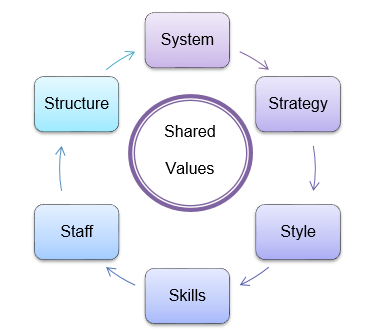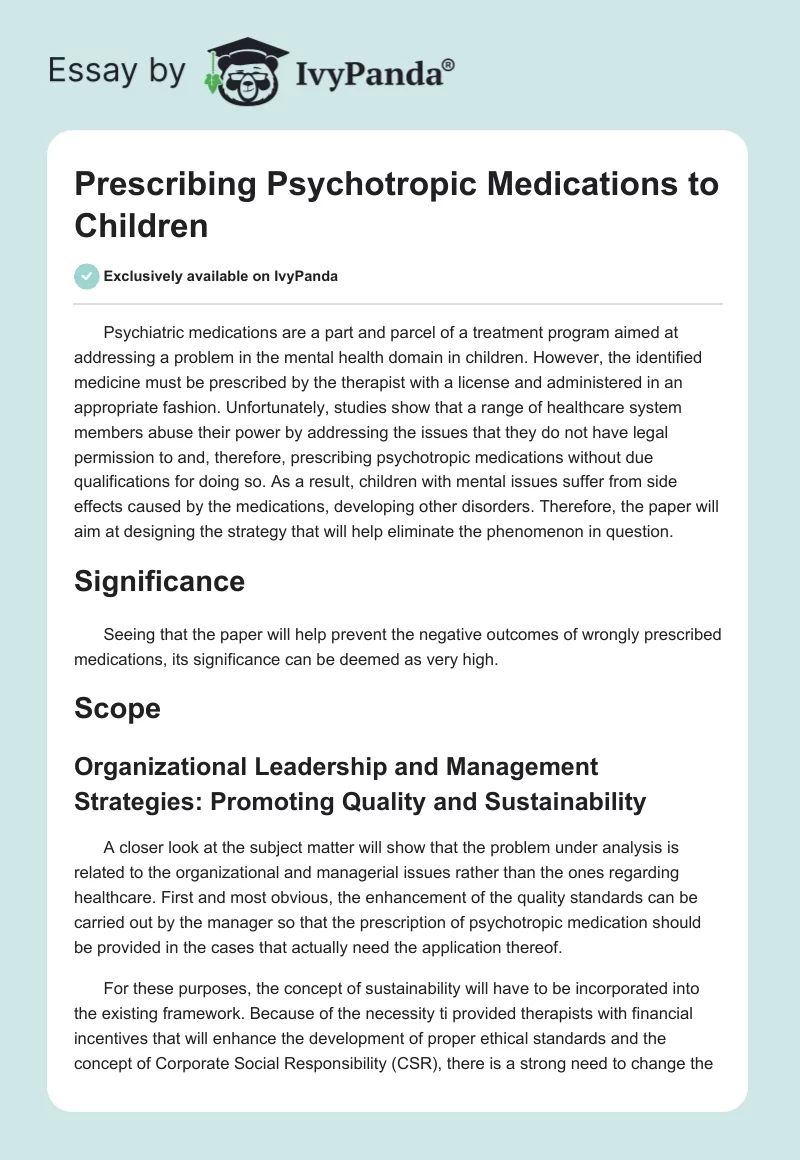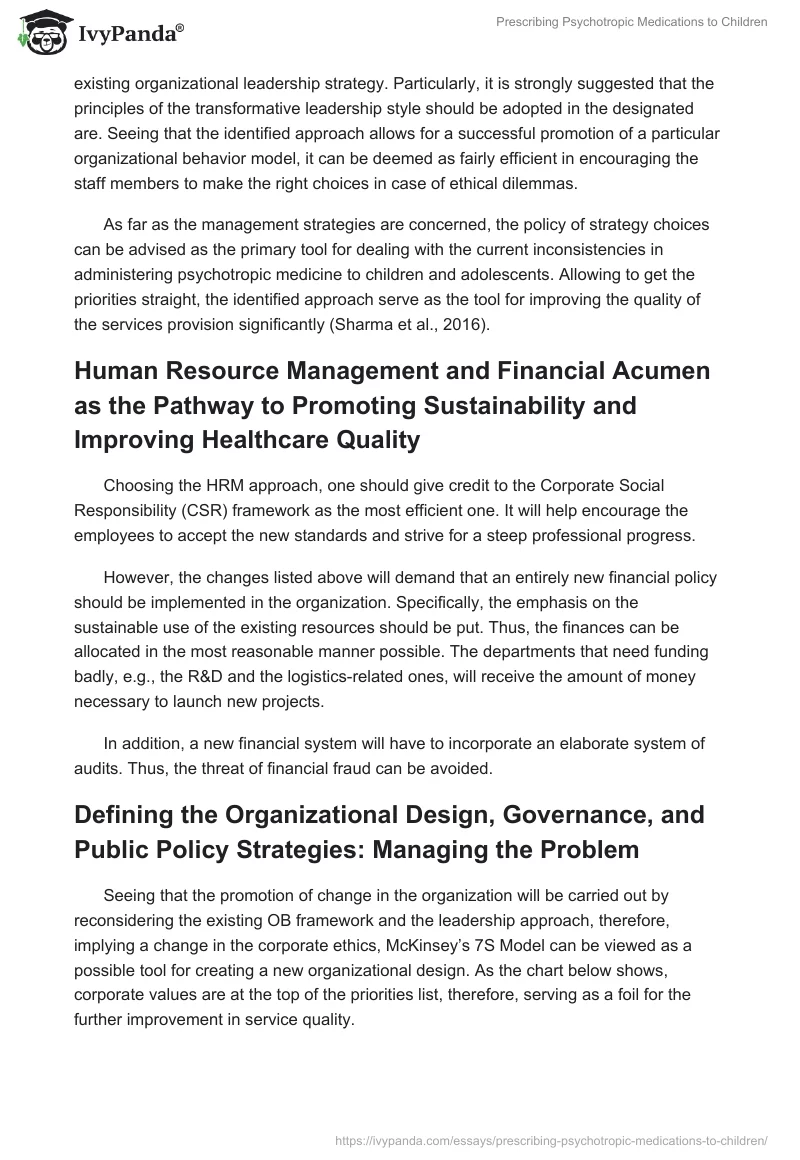Psychiatric medications are a part and parcel of a treatment program aimed at addressing a problem in the mental health domain in children. However, the identified medicine must be prescribed by the therapist with a license and administered in an appropriate fashion. Unfortunately, studies show that a range of healthcare system members abuse their power by addressing the issues that they do not have legal permission to and, therefore, prescribing psychotropic medications without due qualifications for doing so. As a result, children with mental issues suffer from side effects caused by the medications, developing other disorders. Therefore, the paper will aim at designing the strategy that will help eliminate the phenomenon in question.
Significance
Seeing that the paper will help prevent the negative outcomes of wrongly prescribed medications, its significance can be deemed as very high.
Scope
Organizational Leadership and Management Strategies: Promoting Quality and Sustainability
A closer look at the subject matter will show that the problem under analysis is related to the organizational and managerial issues rather than the ones regarding healthcare. First and most obvious, the enhancement of the quality standards can be carried out by the manager so that the prescription of psychotropic medication should be provided in the cases that actually need the application thereof.
For these purposes, the concept of sustainability will have to be incorporated into the existing framework. Because of the necessity ti provided therapists with financial incentives that will enhance the development of proper ethical standards and the concept of Corporate Social Responsibility (CSR), there is a strong need to change the existing organizational leadership strategy. Particularly, it is strongly suggested that the principles of the transformative leadership style should be adopted in the designated are. Seeing that the identified approach allows for a successful promotion of a particular organizational behavior model, it can be deemed as fairly efficient in encouraging the staff members to make the right choices in case of ethical dilemmas.
As far as the management strategies are concerned, the policy of strategy choices can be advised as the primary tool for dealing with the current inconsistencies in administering psychotropic medicine to children and adolescents. Allowing to get the priorities straight, the identified approach serve as the tool for improving the quality of the services provision significantly (Sharma et al., 2016).
Human Resource Management and Financial Acumen as the Pathway to Promoting Sustainability and Improving Healthcare Quality
Choosing the HRM approach, one should give credit to the Corporate Social Responsibility (CSR) framework as the most efficient one. It will help encourage the employees to accept the new standards and strive for a steep professional progress.
However, the changes listed above will demand that an entirely new financial policy should be implemented in the organization. Specifically, the emphasis on the sustainable use of the existing resources should be put. Thus, the finances can be allocated in the most reasonable manner possible. The departments that need funding badly, e.g., the R&D and the logistics-related ones, will receive the amount of money necessary to launch new projects.
In addition, a new financial system will have to incorporate an elaborate system of audits. Thus, the threat of financial fraud can be avoided.
Defining the Organizational Design, Governance, and Public Policy Strategies: Managing the Problem
Seeing that the promotion of change in the organization will be carried out by reconsidering the existing OB framework and the leadership approach, therefore, implying a change in the corporate ethics, McKinsey’s 7S Model can be viewed as a possible tool for creating a new organizational design. As the chart below shows, corporate values are at the top of the priorities list, therefore, serving as a foil for the further improvement in service quality.

The introduction of governance can be viewed as a rather risky step as it will mean that the internal processes will be controlled by the people who have a very basic understanding of the specifics of a certain affiliate of the organization (Alavi & Calleja, 2012). Therefore, the governance process should be rather loose, avoiding to dictate a rigid set of actions yet supervising the essential process closely.
Ethical Leadership Skills and Dispositional Attitudes to Stop the Abuse of Psychotropic Medications
Apart from adopting the transformative leadership approach, one should also consider the trait leadership framework (Fontanella et al.,2014). Since the strategy above allows for making the staff members enthusiastic about the adoption of the new behavioral patterns, it will convince them to base their choices on the healthcare ethics. In other words, the employees will be encouraged to focus on the needs of the patient as their priority. Apart from serving as the means of avoiding possible negative outcomes caused by the prescribed psychotropic medicine, it will also help apply a patient-centered approach, therefore, improving the healthcare services significantly.
A Plan, a Partnership, and a Policy to Consider: Choosing the Appropriate Set of Tools
Plan
- Introducing the transformative leadership strategy into the target environment
- Creating a range of incentives for the healthcare service members;
- Developing the program enhancing the staff’s knowledge and competencies as far as the provision of psychotropic medicine to children is concerned;
- Introducing the staff members to a new set of ethical principles with a strong emphasis on the importance of customer satisfaction and the need to strive from the patient’s wellbeing;
- Evaluating the progress and setting goals for the further development of the healthcare services and its member.
The concept of partnership can be introduced into the organization by making a connection with another healthcare institution. Thus, the process of sharing experience and knowledge can be launched, therefore, serving as the prerequisite to the staff’s further progress, including both personal and professional development (Memari et al., 2012).
Finally, regarding the policy, one should view the concepts of a Just-in-Time (JIT) approach and the framework of Total Quality Management (TQM) as the tools that can possibly improve the current situation. The TQM strategy will serve as the means of enhancing the acquisition of the necessary skills, whereas the JIT approach will create premises for conducting the innovation within the shortest amount of time possible.
Conclusion: Implications of the Strategies to Be Used and The Course for the further Development
Since a range of therapists abuse their power by prescribing psychotropic medicine to children without the right to do so, thus, endangering the patients, a radical change in the context of the current healthcare organizational environment must be made. Making changes in the healthcare setting design is a challenging yet necessary step; particularly, a redesign of the leadership strategy and the subsequent change in values need to be carried out. By applying a different leadership model and enhancing the significance of healthcare ethics, leaders will be able to stop the current power abuse issue and create a safer environment for young patients.
Terms
A psychotropic medication is the medicine that affects one’s cognitive processes and emotional perceptions (Memari et al., 2012).
Off-label prescriptions are the prescriptions that have not been approved by the FDA (Sharma et al., 2016).
Reference List
Alavi, Z., & Calleja, N. G. (2012). Understanding the use of psychotropic medications in the child welfare system: Causes, consequences, and proposed solutions. Child Welfare, 91(2), 77-94.
Fontanella, C., Hiance, D., Phillips, G., Bridge, J., & Campo, J. (2014). Trends in psychotropic medication use for medicaid-enrolled preschool children. Journal of Child & Family Studies, 23(4), 617-631. Web.
Memari, A. H., Ziaee, V., Beygi, S., Moshayedi, P., & Mirfazeli, F. S. (2012). Overuse of psychotropic medications among children and adolescents with autism spectrum disorders: Perspective from a developing country. Research in Developmental Disabilities, 33(2), 563-569. Web.
Sharma, A. N., Arango, C., Coghill, D., Gringras, P., Nutt, D. J., &… Hollis, C. (2016). BAP position statement: Off-label prescribing of psychotropic medication to children and adolescents. Journal of Psychopharmacology, 30(5), 416-421. Web.


